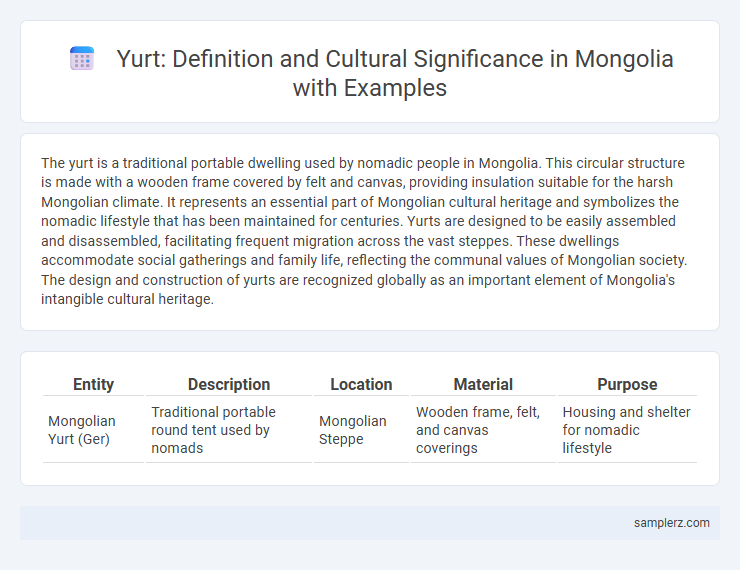The yurt is a traditional portable dwelling used by nomadic people in Mongolia. This circular structure is made with a wooden frame covered by felt and canvas, providing insulation suitable for the harsh Mongolian climate. It represents an essential part of Mongolian cultural heritage and symbolizes the nomadic lifestyle that has been maintained for centuries. Yurts are designed to be easily assembled and disassembled, facilitating frequent migration across the vast steppes. These dwellings accommodate social gatherings and family life, reflecting the communal values of Mongolian society. The design and construction of yurts are recognized globally as an important element of Mongolia's intangible cultural heritage.
Table of Comparison
| Entity | Description | Location | Material | Purpose |
|---|---|---|---|---|
| Mongolian Yurt (Ger) | Traditional portable round tent used by nomads | Mongolian Steppe | Wooden frame, felt, and canvas coverings | Housing and shelter for nomadic lifestyle |
Historical Significance of Yurts in Mongolian Culture
Yurts, traditional portable round tents, have served as essential dwellings for Mongolian nomads for centuries, symbolizing their deep connection to the vast steppes and a nomadic lifestyle. These structures illustrate Mongolian ingenuity in adapting to harsh climates while facilitating mobility during seasonal migrations. The yurt's historical significance is reflected in its role as a cultural emblem of unity, family, and resilience, preserved through generations as a core element of Mongolian heritage.
Traditional Construction Methods of Mongolian Yurts
Mongolian yurts, known locally as "gers," are traditionally constructed using a lattice wall framework (khana) made from lightweight wood, topped with a conical roof supported by a central compression ring (toono) and wooden poles (uni). The structure is covered with layers of felt made from sheep's wool, providing excellent insulation against Mongolia's harsh climate while maintaining portability for nomadic lifestyles. This method reflects centuries of cultural adaptation, combining durability, flexibility, and ecological harmony in traditional Mongolian architecture.
Symbolism and Spiritual Meaning of Yurts in Mongolia
Yurts in Mongolia symbolize the harmony between humans and nature, reflecting the nomadic lifestyle deeply rooted in Mongolian culture. These portable, circular dwellings represent unity, protection, and the cyclical nature of life, often associated with spiritual beliefs tied to the earth and the sky. The yurt's structure embodies the Mongolian worldview, where the central opening (tunduk) is considered a sacred portal connecting the physical and spiritual realms.
Daily Life Inside a Mongolian Yurt
A Mongolian yurt, or ger, serves as a portable and practical home, with a circular shape topped by a wooden lattice framework and a felt covering for insulation. Daily life inside the yurt revolves around family gatherings, cooking on a central stove, and sleeping on traditional felt mats, reflecting a deep connection to nomadic heritage. The interior arrangement prioritizes warmth, functionality, and cultural symbolism, with designated spaces for men, women, and guests.
Yurts as a Reflection of Nomadic Mongolian Identity
Yurts, traditional portable round tents used by Mongolian nomads, symbolize the enduring connection to a mobile lifestyle deeply rooted in Mongolia's vast steppes. These structures are crafted from wood and felt, providing insulation and mobility essential for herding communities adapting to harsh climates. As cultural icons, yurts exemplify the harmony between Mongolian identity and the natural environment, reflecting values of simplicity, resilience, and communal living.
Evolution of Yurt Design in Modern Mongolia
The yurt, a traditional portable dwelling in Mongolia, has evolved significantly to incorporate modern materials such as lightweight aluminum frames and synthetic fabrics, enhancing durability and weather resistance. Contemporary designs blend traditional elements with eco-friendly features, reflecting Mongolia's commitment to sustainable living while preserving cultural heritage. These innovations have allowed yurts to serve as both functional homes in nomadic lifestyles and stylish accommodations in urban settings and tourism.
Yurts in Mongolian Festivals and Celebrations
Yurts, traditional portable round tents, play a central role in Mongolian festivals and celebrations, symbolizing nomadic heritage and communal spirit. During events like Naadam and Tsagaan Sar, yurts serve as venues for social gatherings, rituals, and traditional performances, showcasing Mongolian craftsmanship and cultural identity. Their use highlights the importance of mobility and harmony with nature in Mongolian culture.
Role of Yurts in Mongolian Family Structure
Yurts in Mongolia serve as central living spaces that foster close-knit family bonds and communal interaction. These portable, circular tents symbolize cultural heritage and provide practical shelter suited to the nomadic lifestyle. The yurt's design supports multigenerational living, reinforcing family unity and social organization.
Environmental Adaptations of Mongolian Yurts
Mongolian yurts, or gers, are ingeniously designed to withstand harsh environmental conditions such as extreme cold and strong winds in the Central Asian steppes. Their circular shape and portable wooden frames, covered with layered felt made from sheep's wool, provide excellent insulation and temperature regulation. The yurt's adaptable structure allows easy assembly and disassembly, making it suitable for the nomadic lifestyle and seasonal migrations essential to Mongolian culture.
Preservation of Yurt Traditions in Contemporary Mongolia
Yurts, traditional portable round tents used by Mongolian nomads, remain central to preserving Mongolian cultural identity amid rapid urbanization. Efforts to maintain yurt craftsmanship involve local artisans who pass down construction techniques using felt, wood, and horsehair, ensuring authenticity and sustainability. Cultural festivals and government programs actively promote yurt usage, integrating them into modern life while safeguarding ancestral heritage.

example of "yurt" in "Mongolia Infographic
 samplerz.com
samplerz.com